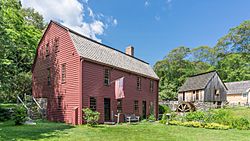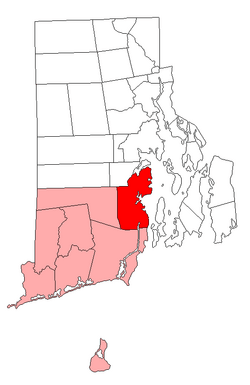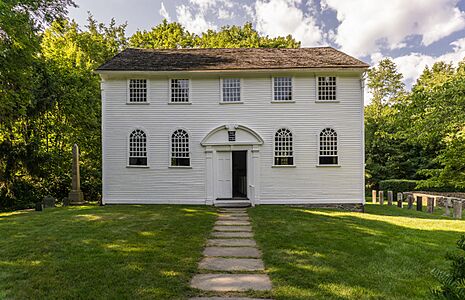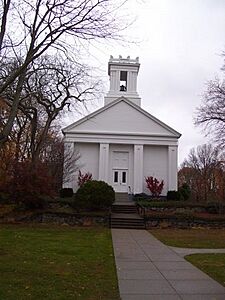North Kingstown, Rhode Island facts for kids
Quick facts for kids
North Kingstown, Rhode Island
|
|
|---|---|

The Gilbert Stuart Birthplace in North Kingstown
|
|
| Nickname(s):
"NK"
|
|

Location of North Kingstown in Washington County, Rhode Island
|
|
| Country | United States |
| State | Rhode Island |
| County | Washington |
| Area | |
| • Total | 58.3 sq mi (151.1 km2) |
| • Land | 43.6 sq mi (112.9 km2) |
| • Water | 14.7 sq mi (38.2 km2) |
| Elevation | 82 ft (25 m) |
| Population
(2020)
|
|
| • Total | 27,732 |
| • Density | 636/sq mi (245.6/km2) |
| Time zone | UTC−5 (Eastern (EST)) |
| • Summer (DST) | UTC−4 (EDT) |
| ZIP codes |
02852 (North Kingstown), 02874 (Saunderstown), 02877 (Slocum)
|
| Area code(s) | 401 |
| FIPS code | 44-51580 |
| GNIS feature ID | 1220088 |
| Website | www.northkingstown.org |
North Kingstown is a town in Washington County, Rhode Island, United States, and is part of the Providence metropolitan area. The population was 27,732 in the 2020 census. North Kingstown is home to the birthplace of American portraitist Gilbert Stuart, who was born in the village of Saunderstown. Within the town is Quonset Point, location of the former Naval Air Station Quonset Point, known for the invention of the Quonset hut, as well as the historic village of Wickford.
Contents
History
The area was first settled by Roger Williams and Richard Smith who set up trading posts near Wickford where Smith's Castle is today. The town of Kings Towne was founded in 1674, by the colonial government, and included the present day towns of North Kingstown, South Kingstown, Exeter, and Narragansett. In 1723, Kings Towne was split into two parts, North Kingstown and South Kingstown, with North Kingstown, having the earliest settlements, retaining the 1674 establishment date. In 1742, the town of Exeter was taken from the western part of North Kingstown.
On September 17, 2024, the National Park Service announced that North Kingstown was named a World War II Heritage City.
Geography
According to the United States Census Bureau, the town has a total area of 58.3 square miles (151 km2), of which 43.6 square miles (113 km2) is land and 14.8 square miles (38 km2) (25.28%) is water. It is bordered on the east by Narragansett Bay.
Demographics
| Historical population | |||
|---|---|---|---|
| Census | Pop. | %± | |
| 1790 | 2,907 | — | |
| 1800 | 2,794 | −3.9% | |
| 1810 | 2,957 | 5.8% | |
| 1820 | 3,007 | 1.7% | |
| 1830 | 3,036 | 1.0% | |
| 1840 | 2,909 | −4.2% | |
| 1850 | 2,971 | 2.1% | |
| 1860 | 3,104 | 4.5% | |
| 1870 | 3,563 | 14.8% | |
| 1880 | 3,949 | 10.8% | |
| 1890 | 4,193 | 6.2% | |
| 1900 | 4,194 | 0.0% | |
| 1910 | 4,048 | −3.5% | |
| 1920 | 3,397 | −16.1% | |
| 1930 | 4,279 | 26.0% | |
| 1940 | 4,604 | 7.6% | |
| 1950 | 14,180 | 208.0% | |
| 1960 | 18,977 | 33.8% | |
| 1970 | 29,793 | 57.0% | |
| 1980 | 21,938 | −26.4% | |
| 1990 | 23,786 | 8.4% | |
| 2000 | 26,326 | 10.7% | |
| 2010 | 26,486 | 0.6% | |
| 2020 | 27,732 | 4.7% | |
| U.S. Decennial Census | |||
As of the 2010 census, there were 26,486 people, 10,436 households, and 7,347 families residing in the town. The racial makeup of the town was 94.7% White, 1.0% African American, 0.6% American Indian/Alaska Native, 1.3% Asian, 0.5% from some other race other races, and 1.9% from two or more races. Hispanic or Latino of any race were 2.4% of the population.
Of the 10,436 households, 70.4% were families, 31.2% had children under the age of 18 living with them, and 29.6% were non-families. 24.2% of all households were made up of householders living alone. The average household size was 2.52 and the average family size was 3.02. 75.4% of households resided in owner-occupied units and 24.6% in rental units.
According to the 2017 American Community Survey, the median income for a household in the town was $87,311 (adjusted to inflation), the median income for a family was $105,954, and the median income for married-couple families was $120,103.
Transportation
Wickford Junction is a terminus station on the Providence/Stoughton Line of the MBTA Commuter Rail, providing weekday train service to Providence Station and Boston's South Station. At 63 miles from Boston, it is the most distant station in the MBTA's 135-station commuter-rail network, and the only one in its most expensive fare zone.
RIPTA also services in the town inbound to Providence and outbound to Narragansett or Newport.
North Kingstown is also served by a passenger ferry connecting to the island of Martha's Vineyard.
Education
North Kingstown School Department is the municipal school district. It operates North Kingstown High School.
Notable people
- Elizabeth Beisel, two-time Olympic medalist swimmer
- John Cole (1715–1777), was a lawyer and 12th Chief Justice of the Rhode Island Supreme Court
- Captain Daniel Fones
- Gilbert Stuart (1755–1828), painter; his portrait of George Washington appears on the one dollar bill
- Dee Dee Myers (born 1961), 19th White House Press Secretary
- Robert J. Papp - Naval Commander and Recipient of the Order of Naval Merit Admiral Padilla
Points of interest
- Casey Farm (1725): An original colonial plantation that is today one of the oldest operational farms in New England.
- Davis Memorial Wildlife Refuge: 96 acres of forest and wetlands preserved by the Audubon Society of Rhode Island.
- Devil's Foot Rock: A footprint-like natural impression or possibly petrosomatoglyph. Legends going back to the colonial era tell of a Native American woman being chased by the devil. Some say that she fled from Boston. Her pursuer is said to have left his footprints at Devil's Foot Rock, then at Chimney Hill in South Kingstown, and finally at Block Island.
- Gilbert Stuart Birthplace and Museum (1751): The house in which American portraitist Gilbert Stuart was born in 1755. The museum features works from throughout Stuart's career and operational grist and snuff mills.
- Historic Wickford Village: A historic seaside village which contains one of the largest collections of preserved 18th-century houses in the Northeastern United States. Wickford also has a large and scenic harbor.
- David S. Baker Estate: Home of Rhode Island's first elected Governor to never be seated.
- Quonset Air Museum: A large museum located at the former Naval Air Station Quonset Point which focuses on military aviation history.
- Smith's Castle (1678): A colonial plantation located on the shore of Narragansett Bay.
- Quonset Point, a former military base which was once the home of the Naval Construction Battalions known as the Seabees
Other National Historic Places in North Kingstown
- Allen-Madison House (1801)
- Camp Endicott (1942)
- Crowfield Historic District
- Davisville Historic District
- George Douglas House (1738)
- George Fayerweather Blacksmith Shop (1819)
- Ezekial Gardner House
- Hamilton Mill Village Historic District
- Lafayette Village
- Stephen Northup House (1712)
- Old Narragansett Cemetery
- Old Narragansett Church (1707)
- Palmer-Northrup House (1680)
- Joseph Pierce Farm
- Plum Beach Light (1899)
- Poplar Point Light (1831)
- Rathbun House
- Esbon Sanford House (1832)
- Saunderstown Historic District
- Six Principle Baptist Church (1703)
- Joseph Slocum House (1750)
- Spink Farm (1798)
- St. Paul's Church (1847)
- YWCA Site
-
Old Narragansett Church, built in 1707, is the oldest Episcopal Church building in New England
See also
 In Spanish: North Kingstown para niños
In Spanish: North Kingstown para niños



